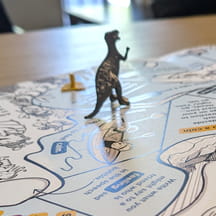From rainbows to redlining, Kansas City kids depicted hope and injustice in their communities.
The drawings were a new and meaningful way for Children’s Mercy Kansas City to gather input from patients and students for their Community Health Needs Assessment (CHNA).
“It is vitally necessary for pediatric health systems to engage youth in their CHNA,” said Austin Strassle, MUP, community benefit manager. “We lose out on a critically important voice within our community if we’re not including their perspectives and ideas.”
With the support of the hospital’s art therapy team and a local school district, kids were asked to reflect on and draw what a healthy community looks like and what problems they see where they live.
Engaging the youth voice
As Strassle and Jeffery Hughley, director of community health, started planning the hospital’s CHNA process, they knew they wanted to push the envelope of how the hospital gathers information to understand its community’s needs.
During this CHNA cycle, the community health team chose to emphasize youth perspectives — not only through in-person meetings, but also through creative mediums.
“We wanted to get kids' perspectives on what they view as the biggest challenges facing the community today, what they see within their own community and school, and how we can provide them with opportunities to grow, learn, and advance into healthy adults,” Hughley said.
From vision to expression
When the idea to incorporate art came to the community health team, they presented it to the CHNA Advisory Committee — made up of representatives and leaders across the health system, including the Patient and Family Services team lead — right away.
Getting hospital leaders on board early made it easier to engage the art therapy team and begin conversations about project planning and logistics. Art Therapist Katie Brewer, MS, LPC, ATR-BC, brainstormed how they could embrace art as a creative outlet for gathering information outside of traditional surveys and as a means of healing and health for kids.
“Art can communicate in a way words can’t, and giving them a voice this way is really empowering,” Brewer said. “It is therapeutic for their voice to be heard, and they want their views on the community around them to be seen.”
To gather these qualitative insights, the community health team provided open-ended questions for participants to address with colored pencils or paints. Brewer used their responses to these questions to write each child’s artist statement.
- What are things in our community that help youth stay healthy?
- What do you think are the biggest problems where we live?
- What do you see when you think of a community where everyone is healthy?
Initial conversations between the art therapy and community health teams led to expanding beyond the hospital to include artwork from local middle and high school students. The director of community outreach and partnerships reached out to an art teacher to build the relationship, and art classes were led using the same prompts.
Diverse perspectives
Common themes in the art projects reflected violence, substance use, homelessness, and environmental concerns.
“It reaffirmed to us that the needs we are seeing and that research is showing are top of mind for the kids who are directly impacted,” Strassle said.

Other art pieces reflected a strong community — one that is bright, diverse, and where individuals can lean on each other. Kids put their vision on paper, drawing “K’s” for “kindness,” students with diverse ethnicities and abilities, and the good that happens when a community supports each other.
“There was a lot of very positive, uplifting, and forward-thinking visioning that shows the strengths that exist within our community right now,” Strassle said. “It was a grounding reminder of the importance and value of the CHNA as something more than just an assessment of need, but as an assessment of opportunity and strength.”
Art into action
The community health team gathered nearly 50 pieces of artwork from patients and students. The paintings and drawings have helped inform the decision-making process for prioritizing needs and amplifying qualitative data gathering.
Children’s Mercy displayed the art at a Children’s Health Summit, an event where CHNA findings were shared with community leaders. And the team is incorporating the drawings and artist statements in the hospital’s final CHNA report.
This was their first time including art, but Strassle and Hughley are already looking to the future. They’d like to enhance the initiative by inviting patient siblings and family members to participate while they visit the hospital.
Going beyond the art
In addition to the creative sessions with patients and students, Children’s Mercy gathered input through more traditional CHNA methods. The community health team conducted six youth focus groups at various community-based organizations. They engaged with young people who identify as LGBTQ+, unhoused children, and maternal youth.
Strassle sees the CHNA as an opportunity rather than a regulatory obligation to maintain Children’s Mercy’s nonprofit status. He said engaging kids in the process is so valuable, it should be required.
“Young people are very tuned into what’s going on in the world, and they have their own concerns and dreams for the future,” Strassle said. “They want to contribute, and they want to be part of the solution that improves community health.”


